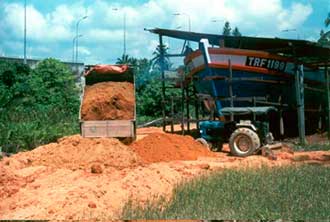the project
The
project of having the Naga Pelangi II built in Duyong
is a tribute to the unique art of the classic wooden boatbuilding that
the Malay culture has created. Like Chengal, the timber used for
the construction, this art is threatened with extinction.

Duyong, 2003: works in the yard
of Hassan bin Ali, where Naga Pelangi II will be built
Throughout
the world, no other shipwrights are using this traditional technique,
in which the planks are fire bent, then joined to each other with ironwood
dowels (Malay: basok) made from "Penaga"-wood (Mesua
Ferea) set 2” apart. Neither plan nor frames, only eye and knowledge
of the master determine the shape of a ships body: the frames are istalled
into the finished hull! There is no European style caulking hammered into
a groove between the planks: the planks are assembled edge on edge with
no groove in between them. The bark of a tree of the "Melaleuka"
species (Malay: kulit gelam) is pushed over the tapered dowels,
sitting in the fitted plank.

hammering
home a plank and applying the caulking bark (kulit gelam) in 2003
Afterwards the new plank is hammered home with about a hundred dowels
snugly slipping into their assigned holes! What an impressive feat! This
creates a hull as if it were made in one casting, where the planks are
separated by a 1–2 mm layer of the kulit gelam bark. This vegetable caulking
keeps the boats dry for their lifetime.
Naga Pelangi II (Malay: Rainbow Dragon) will be a traditional Malay junk of 70 feet (21m) over deck, built using this technique and following the lines of a classic "PINIS".
The
lateral plan (underwater design) will be slightly modified: Contrary to
the standard Terengganu junk, Naga Pelangi II will not be a sailing
freighter, but a pleasure craft. Therefore more emphasis is given to enhance
the sailing ability and less to achieve a maximum loading capacity.

Pinis
"SABAR", museum Terengganu model
of the Naga Pelangi II
A 10 t ballast keel, cast from lead, will
be bolted under the wooden keel.
The timber used throughout the construction of this junk will be "Chengal", an indigenous wood, growing between 5th and 8th latitude of the Malay peninsula only. This deciduous tree, replete with myths, is a “slow grower” reaching a height of close to 200 feet (60 m). It carries the scientific name: "Neobalenocarpus Heimii", family of "Dipterocarpaceae".
With a breaking strength of several times that of oak, both radially and horizontally, Chengal is highly flexible, making it an ideal boatbuilding material for plank bending. Like Teak, it contains preservative compounds that protect the heartwood and even under exposed conditions the timber can last about a hundred years.Termites cannot chew it and freshly cut it is a “sinker”, being heavier than water.
The Malays traditionally use this timber for house and boat construction. You can spot century old houses next to termite mounds all over the countryside. It is said that some even drink a juice squeezed from the sawdust to increase their strength. Nothing but the Teredo-worm, this unscrupulous marine borer, a rampageous mollusc, the scourge of tropical waters can attack this magic wood when it is not protected by antifouling paint. A ban on the export of this timber has been introduced and outside of the national reserves it has become a rare sight.
Fully
cured, Chengal can no longer be bent. Starting a boatbuilding project,
the logs have to be milled, then the planks are placed in the bright sun
to dry for one year. Then construction must begin.

in the sawmill, April 2003: selecting
logs from mountains of CHENGAL
To equal the quality of this timber, we aspire to use only the best material throughout the construction (silicon bronze screws, -boltnuts etc.).
A modern engine should propel the vessel to a speed of 8 knots. A generator should support the solar panels in generating electricity. A reverse osmosis watermaker will produce the freshwater needed and a hydraulic windlass will lift anchor and sails. Three spacious double cabins will offer modern comfort, equipped with shower/toilet and airconditioning.
The ancient looking junk-sails will contrast this modern set-up of down below: Like all the traditional Terengganu junks of her size, Naga Pelangi II will be a junk rigged schooner. In 20 years of sailing a junk-rigged vessel, I have yet to come across a rig surpassing this Malay modified “Chinese Lug Sail” in its ease of handling coupled with aesthetic appeal.
The project was started in spring of 2003 with the buying and stacking of the construction timber. The trees needed for masts, bowsprit and spars were felled as well and prepared (see PHOTO DOCU).The Malays call these trees "Chengal Kampung" (Malay: village) or "Chengal Pasir" (Malay: sand) because this variety of Chengal (Hopea odorata) grows right in their villages, in the sandy soil near water. Therefore their wood is not as hard and heavy as the dschungle Chengal. Following the old custom, the prepared masts and spars were placed in the river for one year, in order to prevent them from cracking while seasoning in the shade later.
Building will commence with the keel being laid in spring of 2004. Completion of the Naga Pelangi II can be expected sometime in 2006. The progress can be monitored viewing the "PHOTO DOCU".
Naga Pelangi II will be deployed as a charter vessel based mainly in Malaysia. But all the waters from Madagascar in the Indian Ocean up to Palau and beyond in the Pacific can be the operational area for this seaworthy junk. Naga Pelangi II can be used as a training ship for junk sailing, for commercial filming, as a comfortable home for scientists in maritime explorations and as a sailing- and dive-charter vessel (see also sponsors & investors for details).